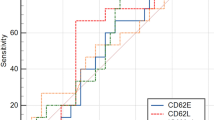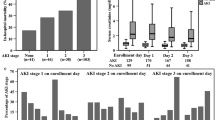Abstract
The pathogenesis of acute kidney injury (AKI) occurring due to sepsis is incompletely understood. Endothelial activation, defined as up-regulation of adhesion molecules by proinflammatory cytokines, may be central to the development of sepsis-induced AKI. Our aim was to determine levels of circulating adhesion molecules endothelial (E)-selectin, intercellular adhesion molecule (ICAM), and vascular cell adhesion molecule (VCAM), inflammatory mediators; tumor necrosis factor-α (TNF-α) and transforming growth factor-β (TGF-β), vasoactive mediators; endothelin-1 (ET-1) and nitric oxide (NO), soluble receptor for advanced glycated end products (sRAGE) and serum fetuin-A in septic AKI patients before and after antibiotic therapy. Nineteen AKI patients with sepsis and fifteen healthy controls were enrolled in this prospective study. Results revealed that 12 weeks of therapy caused amelioration of endothelial and inflammatory injuries as well as renal function markers. Moreover, the positive correlations between levels of RAGE and E-selectin (r = 0.88), ET-1 (r = 0.90), and TNF-α (r = 0.94) and negative with NO (r = −0.75–0.95) suggest that possible interaction of RAGE and inflammation may contribute to endothelial dysfunction in septic AKI patients.


Similar content being viewed by others
Abbreviations
- AKI:
-
Acute kidney injury
- ARF:
-
Acute renal failure
- GFR:
-
Glomerular filtration rate
- ICU:
-
Intensive care unit
- ICAM-1:
-
Intercellular adhesion molecule
- VCAM-1:
-
Vascular cell adhesion molecule
- TNF-α:
-
Tumor necrosis factor-α
- LPS:
-
Lipopolysaccharide
- WBC:
-
White blood count
- TGF-β:
-
Transforming growth factor-β
- ET-1:
-
Endothelin-1
- NO:
-
Nitric oxide
- RAGE:
-
Receptor for advanced glycated end products
- s:
-
Soluble
- IL:
-
Interleukin
- IRI:
-
Ischemia–reperfusion injury
- iNOS:
-
Inducible NO synthase
- eNOS:
-
Endothelial NO synthase
- PGI2 :
-
Prostacyclin
- CRP:
-
C-reactive protein
- HMGB1:
-
High-mobility group box 1
References
Webb S, Dobb G (2007) ARF, ATN or AKI? It’s now acute kidney injury. Anaesth Intensive Care 35(6):843–844
Uchino S, Kellum JA, Bellomo R, Doig GS, Morimatsu H, Morgera S et al (2005) Acute renal failure in critically ill patients: a multicenter study. JAMA 294:813–818
Lameire N, Van Biesen W, Vanholder R (2006) The changing epidemiology of acute renal failure. Nat Clin Pract Nephrol 2(7):364–377
Waikar SS, Liu KD, Chertow GM (2007) The incidence and prognostic significance of acute kidney injury. Curr Opin Nephrol Hypertens 16(3):227–236
Russell JA, Singer J, Bernard GR, Wheeler A, Fulkerson W, Hudson L et al (2000) Changing pattern of organ dysfunction in early human sepsis is related to mortality. Crit Care Med 28:3405–3411
Bagshaw SM, Laupland KB, Doig CJ, Mortis G, Fick GH, Mucenski M et al (2005) Prognosis for long-term survival and renal recovery in critically ill patients with severe acute renal failure: a population-based study. Crit Care 9:R700–R709
Wan J, Bagshaw S, Langenberg B, Saotome T, May C, Bellomo R (2008) Pathophysiology of septic acute kidney injury: what do we really know? Crit Care Med 36(4):S198–S203
Dellinger R, Levy M, Carlet J, Bion J, Parker M, Jaeschke R et al (2008) Surviving Sepsis Campaign: international guidelines for management of severe sepsis and septic shock. Crit Care Med 36:296–327
Himmelfarb J, Joannidis M, Molitoris B, Schietz M, Okusa MD, Warnock D et al (2008) Evaluation and initial management of acute kidney injury. Clin J Am Soc Nephrol 3(4):962–967
Matejovic M (2010) Sepsis induced AKI: mechanisms and targets for intervention. Paper presented at 15th international conference on continuous renal replacement therapies, San Diego
Cohen J (2002) The immunopathogenesis of sepsis. Nature 420:885–887
Carlos TM, Harlan JM (1994) Leukocyte-endothelial adhesion molecules. Blood 84:2068–2101
Michael J, Whalen MD, Lesley A, Doughty MD, Timothy M, Carlos MD et al (2000) Intercellular adhesion molecule-1 and vascular cell adhesion molecule-1 are increased in the plasma of children with sepsis-induced multiple organ failure. Crit Care Med 28:2600–2607
Jaeschke H, Smith CW (1997) Mechanisms of neutrophil-induced parenchymal cell injury. J Leukoc Biol 61:647–653
De Vriese AS (2003) Prevention and treatment of acute renal failure in sepsis. Am Soc Nephrol 14(3):792–805
Khan RZ, Badr KF (1999) Endotoxin and renal function: perspectives to the understanding of septic acute renal failure and toxic shock. Nephrol Dial Transplant 14:814–818
Yanagisawa M, Kurihara H, Kimura S, Tomobe Y, Kobayashi M, Mitsui Y et al (1988) A novel potent vasoconstrictor peptide produced by vascular endothelial cells. Nature 332:411–415
Farrell AJ, Blake DR (1996) Nitric oxide. Ann Rheum Dis 55:7–20
Er H, Evereklioglu C, Cumurcu T, Türköz Y, Ozerol E, Sahin K, Doganay S (2002) Serum homocysteine level is increased and correlated with endothelin-1 and nitric oxide in Behçet’s disease. Br J Ophthalmol 86(6):653–657
Schafer C, Heiss A, Schwarz A, Westenfeld R, Ketteler M, Floege J et al (2003) The serum protein alpha 2-Heremans-Schmid glycoprotein/fetuin-A is a systemically acting inhibitor of ectopic calcification. J Clin Invest 112:357–366
Reynolds JL, Skepper JN, McNair R, Kasama T, Gupta K, Weissberg PL et al (2005) Multifunctional roles for serum protein fetuin-A in inhibition of human vascular smooth muscle cell calcification. J Am Soc Nephrol 16:2920–2930
Keteller M, Bongartz P, Westenfeld R, Wildberger JE, Mahnken AH, Ret Böhm et al (2003) Association of low fetuin-A (AHSG) concentrations in serum with cardiovascular mortality in patients on dialysis: a cross-sectional study. Lancet 361:827–833
Ombrellino M, Wang H, Yang H, Zhang M, Vishnubhakat J, Frazier A et al (2001) Fetuin, a negative acute phase protein, attenuates TNF synthesis and the innate inflammatory response to carrageenan. Shock 15:181–185
Zhou H, Pisitkun T, Aponte A, Yuen PS, Hoffert JD, Yasuda H et al (2006) Exosomal Fetuin-A identified by proteomics: a novel urinary biomarker for detecting acute kidney injury. Kidney Int 70(10):1847–1857
Schmidt AM, Yan SD, Yan SF, Stern DM (2001) The multiligand receptor RAGE as a progression factor amplifying immune and inflammatory responses. J Clin Invest 108:949–955
Gil A, Bengmark S (2007) Advanced glycation and lipoxidation end products–amplifiers of inflammation: the role of food. Nutr Hosp 22(6):625–640
Bohlender JM, Franke S, Stein G, Wolf G (2005) Advanced glycation end products and the kidney. Am J Physiol Renal Physiol 289(4):F645–F659
Haag-Weber M, Horl WH (1996) Are granulocyte inhibitory proteins contributing to enhanced susceptibility to infections in uremia? Nephrol Dial Transplant 11(Suppl 2):S98–S100
Sengoelge G, Födinger M, Skoupy S, Ferrara I, Zangerle C, Rogy M et al (1998) Endothelial cell adhesion molecule and PMNL response to inflammatory stimuli and AGE-modified fibronectin. Kidney Int 54(5):1637–1651
He M, Kubo H, Ishizawa K, Hegab AE, Yamamoto Y, Yamamoto H, Yamaya M (2007) The role of the receptor for advanced glycation end-products in lung fibrosis. Am J Physiol Lung Cell Mol Physiol 293(6):L1427–L1436
Bellomo R, Ronco C, Kellum JA, Mehta RL, Palevsky P, The ADQI Workgroup (2004) Acute renal failure–definition, outcome measures, animal models, fluid therapy and information technology needs: the Second International Consensus Conference of the Acute Dialysis Quality Initiative (ADQI) Group. Crit Care 8:R204–R212
Mehta RL, Kellum JA, Shah SV, Molitoris BA, Ronco C, Warnock DG et al (2007) Acute kidney injury network: report of an initiative to improve outcomes in acute kidney injury. Crit Care (Lond, England) 11(2):31
National Kidney Foundation (2002) K/DOQI clinical practice guidelines for chronic kidney disease: evaluation, classification and stratification. Am J Kidney Dis. 39(2 Suppl 1):S76–S92
Levy M, Fink M, Marshall J, Abraham E, Angus D, Cook D (2001) The 2001 SCCM/ESICM/ACCP/ATS/SIS international sepsis definitions conference. Crit Care Med 31:1250–1256
Bone RC, Balk RA, Cerra FB, Dellinger RP, Fein AM, Knaus WA, ACCP/SCCM Consensus Conference Committee, et al. (2009) Definitions for sepsis and organ failure and guidelines for the use of innovative therapies in sepsis. The ACCP/SCCM Consensus Conference Committee. American College of Chest Physicians/Society of Critical Care Medicine. 1992. Chest. 136(5 Suppl): e28
Jha V, Malhotra HS, Sakhuja V, Chugh KS (1992) Spectrum of hospital acquired acute renal failure in the developing countries—Chandigarh study. QJ Med 84:497–505
Shusterman N, Strom DL, Murray TG, Morrison G, West SL, Maislin G (1987) Risk factors and outcome of hospital-acquired acute renal failure. Clinical epidemiologic study. Am J Med 83:65–71
Wu X, Guo R, Wang Y, Cunningham PN (2007) The role of ICAM-1 in endotoxin-induced acute renal failure. Am J Physiol Renal Physiol 293(4):F1262–F1271
Sutton TA, Fisher CJ, Molitoris BA (2002) Microvascular endothelial injury and dysfunction during ischemic acute renal failure. Kidney Int 62:1539–1549
Pigott R, Dillon LP, Hemingway IH, Gearing AJ et al (1992) Soluble forms of E-selectin, ICAM-1 and VCAM-1 are present in the supernatants of cytokine activated cultured endothelial cells. Biochem Biophys Res Commun 187:584–589
Ficek R, Kokot F, Chudek J, Adamczak M, Ficek J, Wiecek A et al (2006) Plasma concentrations of tumor necrosis factor alpha may predict the outcome of patients with acute renal failure. Kidney Blood Press Res 29:203–209
Sonkar GK, Usha Singh RG (2009) Evaluation of serum tumor necrosis factor alpha and its correlation with histology in chronic kidney disease, stable renal transplant and rejection cases. Saudi J Kidney Dis Transpl 20:1000–1004
Kelly KJ, Williams WW Jr, Colvin RB, Meehan SM, Springer TA, Gutierrez-Ramos JC et al (1996) Intercellular adhesion molecule-1-deficient mice are protected against ischemic renal injury. J Clin Invest 97(4):1056–1063
Phull H, Lien Y-HH, Salkini MW, Escobar C, Lai L-W, Ramakumar S et al (2008) Delivery of intercellular adhesion molecule-1 antisense oligonucleotides using a topical hydrogel tissue sealant in a murine partial nephrectomy/ischemia model. Urology 72(3):690–695
Nemoto T, Burne MJ, Daniels F, O’Donnell MP, Crosson J, Berens K et al (2001) Small molecule selectin ligand inhibition improves outcome in ischemic acute renal failure. Kidney Int 60(6):2205–2214
Kato N, Yuzawa Y, Kosugi T, Hobo A, Sato W, Miwa Y et al (2009) The E-selectin ligand basigin/CD147 is responsible for neutrophil recruitment in renal ischemia/reperfusion. J Am Soc Nephrol 20(7):1565–1576
Burne MJ, Elghandour A, Haq M, Saba SR, Norman J, Condon T et al (2001) IL-1 and TNF independent pathways mediate ICAM-1/VCAM-1 up-regulation in ischemia reperfusion injury. J Leukoc Biol 70(2):192–198
Koong AC, Chen EY, Giaccia AJ (1994) Hypoxia causes the activation of nuclear factor kappa B through the phosphorylation of I kappa B alpha on tyrosine residues. Cancer Res 54:1425–1430
Khachigian LM, Collins T, Fries JW (1997) N-Acetyl cysteine blocks mesangial VCAM-1 and NF-kappa B expression in vivo. Am J Pathol 151:1225–1229
Guan Q, Nguan CY, Du C (2010) Expression of transforming growth factor-beta1 limits renal ischemia–reperfusion injury. Transplantation 89(11):1320–1327
Alejandro V, Scandling JD Jr, Sibley RK, Dafoe D, Alfrey E, Deen W et al (1995) Mechanisms of filtration failure during postischemic injury of the human kidney. A study of the reperfused renal allograft. J Clin Invest 95:820–831
Goligorsky MS, Brodsky SV, Noiri E (2002) Nitric oxide in acute renal failure: NOS versus NOS. Kidney Int 61:855–861
Noiri E, Peresieni T, Miller F, Goligorsky MS (1996) In vivo targeting of inducible NO synthase with oligodeoxynucleotides protects rat kidney against ischemia. J Clin Invest 97:2377–2383
Schneider R, Raff U, Vornberger N, Schmidt M, Freund R, Reber M et al (2003) l-Arginine counteracts nitric oxide deficiency and improves the recovery phase of ischemic acute renal failure in rats. Kidney Int 64:216–225
Kwon O, Hong SM, Ramesh G (2009) Diminished NO generation by injured endothelium and loss of macula densa nNOS may contribute to sustained acute kidney injury after ischemia–reperfusion. Am J Physiol Renal Physiol 296:F25–F33
Ikeda U, Yamamoto K, Maeda Y, Shimpo M, Kanbe T, Shimada K (1997) Endothelin-1 inhibits nitric oxide synthesis in vascular smooth muscle cells. Hypertension 29:65–69
Lebreton JP, Joisel F, Raoult JP, Lannuzel B, Rogez JP, Humbert G (1979) Serum concentration of human alpha 2 HS glycoprotein during the inflammatory process: evidence that alpha 2 HS glycoprotein is a negative acute-phase reactant. J Clin Invest 64:1118–1129
Demetriou M, Binkert C, Sukhu B, Tenenbaum HC, Denni JW (1996) Fetuin/alpha2-HS glycoprotein is a transforming growth factor-beta type II receptor mimic and cytokine antagonist. J Biol Chem 271:12755–12761
Bopp C, Bierhaus A, Hofer S, Bouchon A, Nawroth PP, Martin E, Weigand MA (2008) Bench-to-bedside review: the inflammation-perpetuating pattern-recognition receptor RAGE as a therapeutic target in sepsis. Crit Care 12:201
Hricik DE, Schulak JA, Sell DR, Fogarty JF, Monnier VM (1993) Effects of kidney or kidney–pancreas transplantation on plasma pentosidine. Kidney Int 43(2):398–403
Basta G, Schmidt AM, De Caterina R (2004) Advanced glycation end products and vascular inflammation: implications for accelerated atherosclerosis in diabetes. Cardiovasc Res 63:582–592
Rojas A, Romay S, Gonzalez D, Herrera B, Delgado R, Otero K (2000) Regulation of endothelial nitric oxide synthase expression by albumin-derived advanced glycosylation end products. Circ Res 86:E50–E54
Xu B, Chibber R, Ruggerio D, Kohner E, Ritter J, Ferro A (2003) Impairment of vascular endothelial nitric oxide synthase activity by advanced glycation end products. FASEB J 17:1289–1291
Bucala R, Tracey KJ, Cerami A (1991) Advanced glycosylation products quench nitric oxide and mediate defective endothelium-dependent vasodilatation in experimental diabetes. J Clin Invest 87(2):432–438
Huang W, Liu Y, Li L, Zhang R, Liu W, Wu J, Mao E, Tang Y (2011) HMGB1 increases permeability of the endothelial cell monolayer via RAGE and Src family tyrosine kinase pathways. Inflammation (in press)
Acknowledgments
The authors gratefully acknowledge the financial assistance provided by Faculty of Pharmacy, Cairo University, Cairo, Egypt. We gratefully acknowledge Nephrology department, Faculty of Medicine, Cairo University.
Conflict of interest
The authors declare that there are no conflict of interest.
Author information
Authors and Affiliations
Corresponding author
Electronic supplementary material
Below is the link to the electronic supplementary material.
Rights and permissions
About this article
Cite this article
Sadik, N.A.H., Mohamed, W.A. & Ahmed, M.I. The association of receptor of advanced glycated end products and inflammatory mediators contributes to endothelial dysfunction in a prospective study of acute kidney injury patients with sepsis. Mol Cell Biochem 359, 73–81 (2012). https://doi.org/10.1007/s11010-011-1001-4
Received:
Accepted:
Published:
Issue Date:
DOI: https://doi.org/10.1007/s11010-011-1001-4




